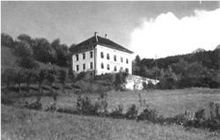Grete Gulbransson

Grete Gulbransson b. Jehly (born July 31, 1882 in Bludenz , Vorarlberg , † March 26, 1934 in Munich ) was an Austrian writer and local poet.
Life
Margarethe was born as the daughter of the painter Jakob Jehly and his wife Wanda (née Baroness von Pöllnitz, widowed Wanda Douglass ) in Bludenz and grew up as "Haldagreteli" on the so-called Halde. After the death of her parents, the 19-year-old settled in Munich, where she made close contacts with the legendary Simplicissimus group around the publisher and patron of culture Albert Langen . Through Langen she met the Norwegian painter and Simplicissimus caricaturist Olaf Gulbransson (1873-1958), whom she married on August 14, 1906 in Munich. Grete was Olaf's second wife. A close friend of the couple was Josephine Rensch , who was in a very similar situation with Albert Langen as Grete when she fell in love with Olaf, who was still married.
The marriage with Gulbransson, who later became the architect and church builder Olaf Andreas Gulbransson , was divorced in March 1923. Due to financial difficulties, Grete Gulbransson had to rent out her house in Munich on Keferstraße, which is why the center of her life moved back to Vorarlberg at the end of the 1920s. From 1930 to January 1934 she lived at Weissenberg Castle in Batschuns .
Literary work
Grete Gulbransson achieved a certain degree of notoriety after her death with the family saga Beloved Shadow, which was published in Vorarlberg in 1934 and has since been reissued several times . Through her parents' house, she came into contact with culture and art as a child and dealt with literature, especially poetry, from an early age. In 1914 her first volume of poetry appeared, which she called Poems . The second followed in 1922 (Eternal Call) . In later years she also tried her hand at drama; in 1932 she published a homeland piece about Johann Josef Batlogg . The ballad Ehreguta and smaller prose sketches were also created in 1932 . Parallel to her writing activity, she kept a sporadic diary from 1892 and consistently from 1896 onwards . These extensive records, which she describes as her life's work , 222 volumes with around 90,000 handwritten pages, give detailed insights into the cultural events on the one hand regional (Vorarlberg and Liechtenstein ) and on the other hand internationally (Italy, Munich, Vienna, Berlin, England, Norway) influenced milieus. At the same time, they document the paradigm shift that took place in almost all areas of life in the first decades of the twentieth century and shaped early European modernity.
estate
Most of the correspondence is in private hands, the diary autographs belong to the Vorarlberg State Museum in Bregenz. They were made available to the Brenner Archive Research Institute at the University of Innsbruck for one of the edition projects.
Works
Prose, poetry, drama
- Beloved shadows. A chronicle of home . Grote, Berlin 1934 (new edition Bregenz, H. Lingenhöle and Co 1995. ISBN 3-85162-016-X ).
- Poems . Fischer, Berlin 1914.
- Eternal reputation . Musarion, Munich 1922.
- Batlogg. Montafoner Heimatstück in 6 pictures, self-published by the Verkehrsverein, Schruns 1932.
- Ehreguta. Ballad . F. Dworzak, Bludenz 1932.
- Publication of prose sketches in the Vorarlberger Tagblatt , in the Vorarlberger Zeitschrift Heimat , and in the Bodenseebuch .
Diaries
- The green bird of the ether. Grete Gulbransson: Diaries Volume I: 1904 to 1912 , ed. u. come over. v. Ulrike Lang. Stroemfeld, Frankfurt am Main 1998, ISBN 3-87877-690-X .
- My strange world. Grete Gulbransson: Diaries Volume II: 1913 to 1918 , ed. u. come over. v. Ulrike Lang. Stroemfeld, Frankfurt am Main, ISBN 3-87877-692-6 .
- Beloved Liechtenstein. Diaries Volume IV: 1927 to 1929 , ed. u. come over. v. Ulrike Lang. Stroemfeld, Frankfurt am Main 2003, ISBN 3-87877-696-9 .
literature
- Christa Binder : The making of Grete Gulbransson's “Beloved Shadows” . Univ. Dipl.-Arb. Innsbruck 1995.
- Manfred Bosch : Boheme on Lake Constance. Literary life on Lake Constance from 1900 to 1950. 2nd edition, Libelle, Lengwil 1997.
- Ulrike Lang: Grete Gulbransson's diaries at the intersection of regional and supraregional interests. In: Jochen Golz (Ed.): Editio (supplements). Edition of autobiographical writings and testimonials on biography , Vol. 7. Niemeyer, Tübingen 1995, ISBN 3-484-29507-4 , pp. 123-132.
- Hans Nägele : Grete Gulbransson. An outline of the life and work of the Vorarlberg poet . Mayer, Dornbirn 1954.
- Grete Gulbransson Jehly (1882–1934) , in: Villa Falkenhorst . Bludenzer Geschichtsblätter Heft 66 + 67 (2002), ISBN 3-901833-16-1 , pp. 131–142.
- Gulbransson Grete. In: Austrian Biographical Lexicon 1815–1950 (ÖBL). Volume 2, Verlag der Österreichischen Akademie der Wissenschaften, Vienna 1959, p. 106.
Web links
- Literature by and about Grete Gulbransson in the catalog of the German National Library
- Ulrike Lang: Publications as part of the Grete Gulbransson diary edition (selection)
- Project edition of Grete Gulbransson's diaries
- Villa Falkenhorst - Portrait of Grete Gulbransson
- Vorarlberger Landesbibliothek : Franz-Michael-Felder-Archiv: Grete Gulbransson holdings kept.
| personal data | |
|---|---|
| SURNAME | Gulbransson, Grete |
| ALTERNATIVE NAMES | Jehly, Margarethe (maiden name) |
| BRIEF DESCRIPTION | Austrian writer and local poet |
| DATE OF BIRTH | July 31, 1882 |
| PLACE OF BIRTH | Bludenz , Vorarlberg, Austria |
| DATE OF DEATH | March 26, 1934 |
| Place of death | Munich , Bavaria |
